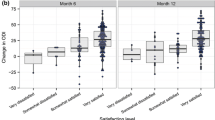Abstract
Purpose
The Majeed scoring system is a disease-specific outcome measure that was originally designed to assess pelvic injuries. The aim of this study was to determine the psychometric properties of the Majeed scoring system for chronic sacroiliac joint pain.
Methods
Internal consistency, content validity, criterion validity, construct validity and responsiveness to change was assessed prospectively for the Majeed scoring system in a cohort of 60 patients diagnosed with sacroiliac joint pain. This diagnosis was confirmed with CT-guided sacroiliac joint anaesthetic block.
Results
The overall Majeed score showed acceptable internal consistency (Cronbach alpha = 0.63). Similarly, it showed acceptable floor (0 %) and ceiling (0 %) effects. On the other hand, the domains of pain, work, sitting and sexual intercourse had high (>30 %) floor effects. Significant correlation with the physical component of the Short Form-36 (p = 0.005) and Oswestry disability index (p ≤ 0.001) was found indicating acceptable criterion validity. The overall Majeed score showed acceptable construct validity with all five developed hypotheses showing significance (p ≤ 0.05). The overall Majeed score showed acceptable responsiveness to change with a large (≥0.80) effect size and standardized response mean.
Conclusion
Overall the Majeed scoring system demonstrated acceptable psychometric properties for outcome assessment in chronic sacroiliac joint pain. Thus, its use in this condition is adequate. However, some domains demonstrated suboptimal performance indicating that improvement might be achieved with the development of an outcome measure specific for sacroiliac joint dysfunction and degeneration.
Similar content being viewed by others
References
Wise CL, Dall BE (2008) Minimally invasive sacroiliac arthrodesis: outcomes of a new technique. J Spinal Disord Tech 21(8):579–584
Khurana A, Guha AR, Mohanty K, Ahuja S (2009) Percutaneous fusion of the sacroiliac joint with hollow modular anchorage screws: clinical and radiological outcome. J Bone Joint Surg Br 91(5):627–631
Al-Khayer A, Hegarty J, Hahn D, Grevitt MP (2008) Percutaneous sacroiliac joint arthrodesis: a novel technique. J Spinal Disord Tech 21(5):359–363
Mason LW, Chopra I, Mohanty K (2013) The percutaneous stabilisation of the sacroiliac joint with hollow modular anchorage screws: a prospective outcome study. Eur Spine J 22(10):2325–2331
Whang P, Cher D, Polly D, Frank C, Lockstadt H, Glaser J, Limoni R, Sembrano J (2015) Sacroiliac joint fusion using triangular titanium implants vs. non-surgical management: six-month outcomes from a prospective randomized controlled trial. Int J Spine Surg 9:6
Van Loon P, Kuhn S, Hofmann A, Hessmann MH, Rommens PM (2011) Radiological analysis, operative management and functional outcome of open book pelvic lesions: a 13-year cohort study. Injury 42(10):1012–1019. doi:10.1016/j.injury.2010.11.057
Lefaivre KA, Slobogean GP, Ngai JT, Broekhuyse HM, OBrien PJ (2014) What outcomes are important for patients after pelvic trauma? Subjective responses and psychometric analysis of three published pelvic-specific outcome instruments. J Orthop Trauma 28(1):23–27
Majeed SA (1989) Grading the outcome of pelvic fractures. J Bone Joint Surg Br 71(2):304–306
Cook DA, Beckman TJ (2006) Current concepts in validity and reliability for psychometric instruments: theory and application. Am J Med 119(2):166.e7-16
Kocher MS, Steadman JR, Briggs KK, Sterett WI, Hawkins RJ (2004) Reliability, validity, and responsiveness of the Lysholm knee scale for various chondral disorders of the knee. J Bone Joint Surg Am 86(6):1139–1145
Robinson HS, Brox JI, Robinson R, Bjelland E, Solem S, Telje T (2007) The reliability of selected motion- and pain provocation tests for the sacroiliac joint. Man Ther 12(1):72–79
Simopoulos TT, Manchikanti L, Singh V, Gupta S, Hameed H, Diwan S, Cohen SP (2012) A systematic evaluation of prevalence and diagnostic accuracy of sacroiliac joint interventions. Pain Physician 15(3):E305–E344
Lefaivre KA, Slobogean GP, Valeriote J, O’Brien PJ, Macadam SA (2012) Reporting and interpretation of the functional outcomes after the surgical treatment of disruptions of the pelvic ring: a systematic review. J Bone Joint Surg Br 94(4):549–555
Van den Bosch EW, Van der Kleyn R, Hogervorst M, Van Vugt AB (1999) Functional outcome of internal fixation for pelvic ring fractures. J Trauma 47(2):365–371
Cohen SP, Williams KA, Kurihara C, Nguyen C, Shields C, Kim P, Griffith SR, Larkin TM, Crooks M, Williams N, Morlando B, Strassels SA (2010) Multicenter, randomized, comparative cost-effectiveness study comparing 0, 1, and 2 diagnostic medial branch (facet joint nerve) block treatment paradigms before lumbar facet radiofrequency denervation. Anesthesiology 113(2):395–405
Rupert MP, Lee M, Manchikanti L, Datta S, Cohen SP (2009) Evaluation of sacroiliac joint interventions: a systematic appraisal of the literature. Pain Physician 12(2):399–418
Borowsky CD, Fagen G (2008) Sources of sacroiliac region pain: insights gained from a study comparing standard intra-articular injection with a technique combining intra- and peri-articular injection. Arch Phys Med Rehabil 89(11):2048–2056
Kibsgård TJ, Røise O, Sudmann E, Stuge B (2013) Pelvic joint fusions in patients with chronic pelvic girdle pain: a 23-year follow-up. Eur Spine J 22(4):871–877
Acknowledgments
We would like to thank Mark Goodson at the University Hospital Llandough for data collection. As well as, Dr. Jan Hermann Kuiper at Keele University for advice on study design.
Author information
Authors and Affiliations
Corresponding author
Ethics declarations
Conflict of interest
No benefits in any form have been received or will be received from a commercial party related directly or indirectly to the subject of this article.
Rights and permissions
About this article
Cite this article
Bajada, S., Mohanty, K. Psychometric properties including reliability, validity and responsiveness of the Majeed pelvic score in patients with chronic sacroiliac joint pain. Eur Spine J 25, 1939–1944 (2016). https://doi.org/10.1007/s00586-015-4369-0
Received:
Revised:
Accepted:
Published:
Issue Date:
DOI: https://doi.org/10.1007/s00586-015-4369-0




